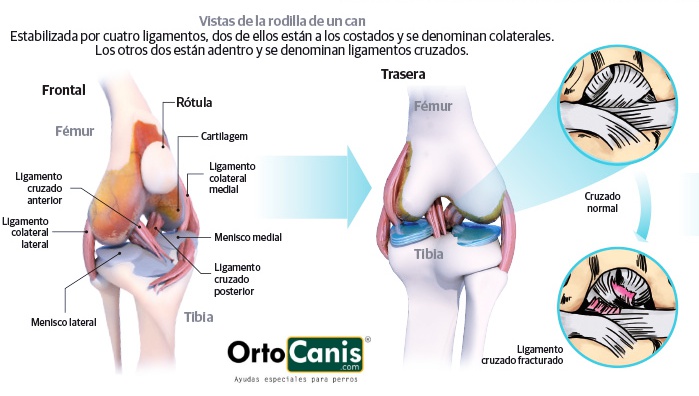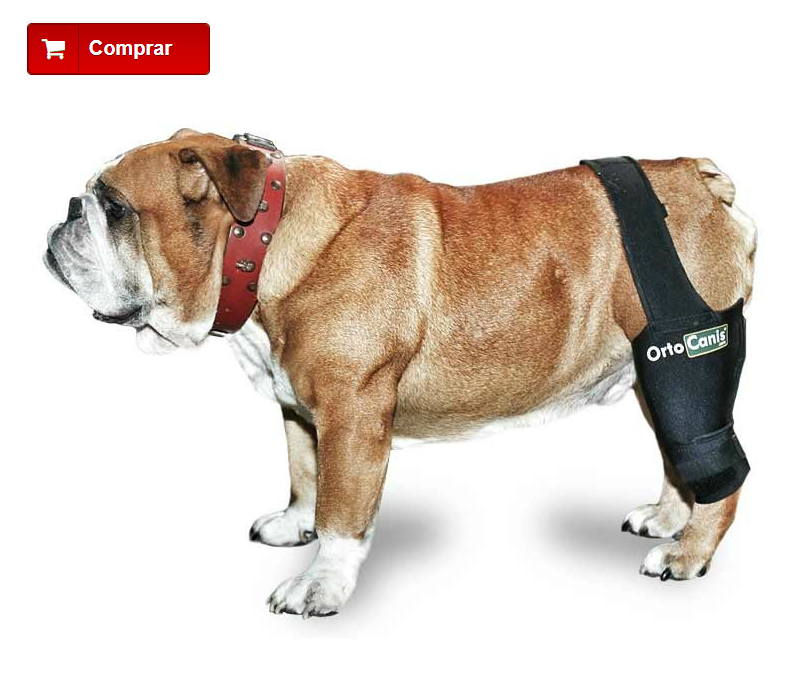The knee joint is quite unstable compared to other parts of the body, so they are relatively easy to injure. Knee problems can appear from various causes, although the most frequent have a traumatic origin. They are often due to blows, sudden movements or appear after intense exercise. Lameness in these cases is common.
In the dog's hind legs, the knee joint is the central joint. It is in turn composed of two different joints: the joint between the femur and the tibia and the joint between the femur and the patella.
FRONT AND REAR VIEW OF THE DOG'S RIGHT KNEE
In the joint between femur and tibia different elements participate, thus allowing bending movements and xvoltage:
Ligaments: they provide firmness and also provide the strength and stability necessary to support the weight of the dog, allowing adequate movement as well as the correct positioning of the joint.
The main ligaments of this joint are the collateral ligaments together with the cruciate ligaments.
-
Most common problem : rupture of the cruciate ligaments, in particular of the Anterior cruciate ligament.
- Causes: Traumatic or degenerative. There is a predisposition according to race and factors such as overweight, sedentary lifestyle, endocrine disorders or sudden movements such as jumping off the sofa can be the cause.
-
Symptoms : swelling, pain, lameness and lack of support of the limb.
The menisci: They are pieces of elastic and resistant cartilage tissue that cushion impacts, provide stability and improve joint cohesion. Its function is the correct coupling between the femur and the tibia.
-
Most common problem : Meniscus injuries such as fissures or roughness occur frequently.
-
Causes:They can be traumatic, mechanical, or degenerative. The medial meniscus is the most affected and the damage is usually related to the rupture of the anterior cruciate ligament.
-
Symptoms : severe pain and a clicking sound in flexion movements of the limb.Thejoint between the femur and the patella forms a type of pulley-like joint. A peculiarity of the knee joint is that all the movements that take place between the tibia and the femur also occur between the patella and the femur, so that the displacement of both joints is carried out synchronously. This is possible thanks to the union of the patella to a ligament that connects it to the tibia and to a tendon that connects it to a femoral muscle.
Patella Within the structures that make up the knee, there are small bones called sesamoids, which favor the displacement of tendons and muscles in the joint. Among them, the patella is the largest sesamoid. The dog's knee consists of 4 sesamoideos while the human only has the patella.
-
Most common problem: patella luxation it is a common injury, in which the kneecap slips out of its usual location in the femur. The patella luxation medial is the most frequent.
-
Causes: May be due to congenital causes or trauma, such as bumps, falls, or collisions.
-
Symptoms: reduced activity, increased sensitivity, pain, weakness and the presence of crackles ..
Knee pathologies cause the loss of stability in the joint and often trigger osteoarthritis.
The knee orthosis they compensate for the loss of function of the dog's joint and reduce lateral displacement of the knee. Thanks to the increase in blood flow and the working temperature of the joint, pain is reduced in cases of arthritis or osteoarthritis, cruciate ligament injury, meniscus injury, patella problems and tendinitis. They represent a type of conservative orthopedic treatment that allows the patella to be kept in its correct location with respect to the femur in a way that avoids pain and instability.
The articulated knee orthosis They are useful in cases in which the surgery has not had the expected results, is contraindicated or it is decided not to operate for different reasons. This type of orthosis is used especially in cases of patella dislocation, to limit lateral movements and provide more stability, thanks to the aluminum lateral joints that they incorporate.
Ortocanis Veterinary Team



